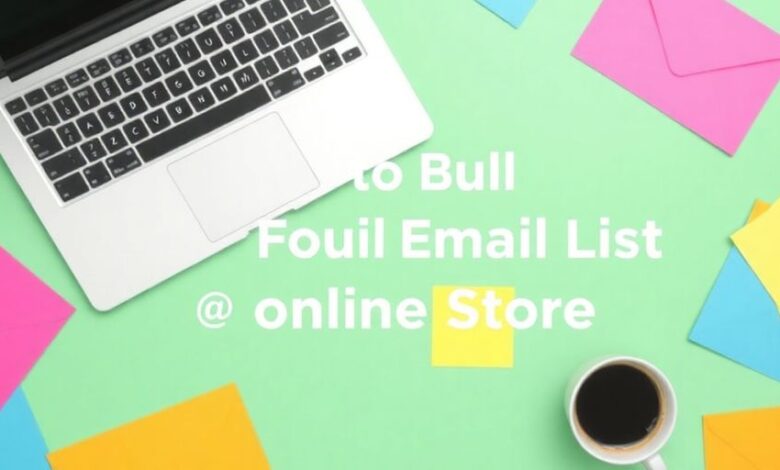Unlocking Profits: How to Build an Email List That Prints Money for Your Online Store

Building an email list is like planting a money tree for your online store. It’s not just about collecting addresses; it’s about creating a direct line to your customers. With a well-crafted email list, you can boost sales, keep customers coming back, and even turn casual shoppers into loyal fans. In this article, we’ll explore how to build an email list that prints money for your online store, offering practical tips and strategies that you can implement right away.
Key Takeaways
- Email marketing can yield a return on investment of 122%, making it a powerful tool for online stores.
- Offering incentives like discounts or freebies can significantly boost your email sign-up rates.
- Engaging subject lines and personalized content can improve your email open and click rates.
- Utilizing both online and offline strategies can help expand your email list more effectively.
- Regularly cleaning your email list and analyzing performance metrics can ensure your campaigns remain effective.
Understanding the Importance of Email Lists

Email Marketing ROI Explained
So, you’re probably wondering if building an email list is even worth the effort. Let me tell you, it absolutely is! Email marketing isn’t some outdated tactic; it’s a powerhouse when done right. The return on investment (ROI) for email marketing is seriously impressive. Think about it: you’re directly reaching people who have already shown interest in what you have to offer. That’s way more effective than shouting into the void of social media. It’s like having a direct line to your ideal customer. You can send targeted messages, promote special deals, and build real relationships. It’s not just about blasting out emails; it’s about creating value for your subscribers. Plus, it’s way more affordable than many other marketing channels. You don’t need a huge budget to get started, and the potential payoff is huge. It’s a no-brainer for any online store looking to grow. You can check out an ultimate guide to email marketing to learn more.
Why Email Lists Are Essential for E-Commerce
Okay, so why are email lists so important for e-commerce specifically? Well, for starters, you own your email list. Unlike social media platforms, where algorithms can change on a whim and limit your reach, you have direct access to your subscribers’ inboxes. That’s huge! It means you’re not relying on a third party to connect with your audience. Plus, email allows for personalized communication. You can segment your list based on customer behavior, purchase history, and demographics, and then send targeted messages that resonate with each group. This leads to higher engagement, more sales, and increased customer loyalty. Think about sending a special discount to customers who abandoned their carts or promoting new products to those who have purchased similar items in the past. It’s all about making your customers feel valued and understood. Email marketing also helps you build brand awareness and establish yourself as an authority in your niche. By consistently providing valuable content and exclusive offers, you can keep your brand top of mind and turn subscribers into loyal customers.
The Role of Email in Customer Retention
Customer retention is where email marketing really shines. It’s way easier (and cheaper) to keep an existing customer than to acquire a new one. Email allows you to stay in touch with your customers long after they’ve made a purchase. You can send thank-you emails, provide updates on new products, offer exclusive discounts, and ask for feedback. This helps you build a strong relationship with your customers and keep them coming back for more. Think about sending a personalized birthday email with a special offer or providing early access to new product launches for your most loyal customers. It’s all about making them feel appreciated and valued. Email marketing is a powerful tool for building customer loyalty and driving repeat business.
Email marketing is not just about sending promotional messages; it’s about building relationships with your customers and providing them with value. By consistently delivering relevant and engaging content, you can turn subscribers into loyal fans and drive long-term growth for your online store.
Here’s a simple breakdown of why email is great for retention:
- Personalized communication builds stronger bonds.
- Exclusive offers make customers feel valued.
- Consistent engagement keeps your brand top of mind.
Strategies for Building Your Email List
Creating Compelling Lead Magnets
Okay, so you want people to actually want to give you their email address, right? The secret sauce is a killer lead magnet. A lead magnet is basically something super valuable that you give away for free in exchange for an email address. Think of it like this: you’re offering a solution to a problem your potential customers have.
Here are some ideas:
- A free ebook or guide
- A checklist or cheat sheet
- A discount code or free shipping
- Access to a free webinar or course
Make sure your lead magnet is relevant to your audience and delivers on its promise. If it’s not good, people will unsubscribe faster than you can say “spam.”
Utilizing Social Media for List Growth
Social media isn’t just for posting pictures of your lunch; it’s a goldmine for email list building. You’ve already got an audience there, so why not tap into it?
Here’s how:
- Run contests and giveaways that require an email address to enter.
- Promote your lead magnet on all your social media channels.
- Use social media ads to target potential subscribers.
- Add a call-to-action button on your Facebook page that directs people to your sign-up form.
Don’t just blast your followers with sign-up requests. Provide real value and make it clear what they’ll get in return for subscribing.
Incorporating Sign-Up Forms on Your Website
Your website is prime real estate for capturing email addresses. But slapping a generic sign-up form on your homepage isn’t going to cut it. You need to be strategic about where and how you place your forms.
Here are some tips:
- Use pop-up forms (but don’t be annoying – time them right!).
- Embed forms in your blog posts.
- Add a sign-up form to your website’s footer.
- Create a dedicated landing page for email sign-ups.
Make sure your sign-up forms are visually appealing and easy to use. Nobody wants to fill out a form that looks like it was designed in 1998. Keep it simple, clear, and mobile-friendly.
Optimizing Your Email Campaigns
Crafting Engaging Subject Lines
Subject lines are your first, and sometimes only, chance to grab attention. Think of them as tiny billboards in a crowded digital space. A boring subject line equals a missed opportunity. The goal is to pique curiosity and create a sense of urgency without resorting to clickbait tactics.
- Keep it short and sweet: Mobile users will thank you.
- Personalize when possible: Use the subscriber’s name or location.
- A/B test different approaches: See what resonates with your audience.
Subject lines are the gatekeepers to your email content. If they fail, your carefully crafted message will never be seen. Experiment with different styles and tones to find what works best for your audience.
Segmenting Your Audience for Better Results
Not all subscribers are created equal. Sending the same email to everyone is like shouting into a void. Segmentation allows you to divide your list into smaller groups based on demographics, purchase history, interests, or behavior. This way, you can send targeted messages that are more relevant and engaging. For example, you can prevent card abandonment by sending emails to people who put items into the cart but didn’t complete the purchase.
- New subscribers: Send a welcome series.
- Loyal customers: Offer exclusive discounts.
- Inactive subscribers: Try a re-engagement campaign.
A/B Testing Your Email Content
A/B testing, also known as split testing, is a method of comparing two versions of an email to see which one performs better. It’s a data-driven way to optimize your campaigns and improve your results. Test everything from subject lines and body copy to calls-to-action and images.
Here’s a simple example:
| Element | Version A | Version B |
|---|---|---|
| Subject Line | “Sale Ends Tonight!” | “Last Chance for 20% Off” |
| Call to Action | “Shop Now” | “Get Your Discount” |
- Test one element at a time: This ensures you know what’s driving the results.
- Use a statistically significant sample size: The larger the sample, the more reliable the results.
- Analyze the data and implement the winning version: Continuously improve your campaigns based on your findings. You can increase your conversion rates by sending each email to segmented subscribers who will be most interested in the content.
Leveraging Offline Opportunities for Email Sign-Ups

It’s easy to think that building your email list is all about online tactics, but don’t forget the real world! There are plenty of chances to grab email addresses when you’re offline. You might be surprised how effective these methods can be, especially when you combine them with your online efforts.
Collecting Emails at Events
Events are goldmines for potential subscribers. Whether it’s a local craft fair, a trade show, or even a community gathering, make sure you’re ready to collect email addresses. Have a sign-up sheet handy, or better yet, set up a tablet with a simple form. Make it quick and easy for people to subscribe right then and there. Don’t forget to tell them what they’ll get by signing up – exclusive deals, early access, or helpful content. You can even run a small contest to incentivize sign-ups. For example:
- Offer a discount code for anyone who signs up at the event.
- Give away a free product or service to one lucky subscriber.
- Provide a small freebie just for signing up.
Using Print Materials to Drive Sign-Ups
Print isn’t dead! Think about all the physical materials your business uses: business cards, brochures, flyers, even receipts. Each one is an opportunity to promote your email list. Include a QR code that links directly to your email signup page. Make sure the call to action is clear and compelling. For example, instead of just saying “Sign up for our newsletter,” try something like “Get 10% off your next order when you join our email list!”
Don’t underestimate the power of a well-placed call to action on your print materials. It’s a simple way to turn offline interactions into online subscribers.
Engaging Customers Through Direct Mail
Okay, direct mail might seem a little old-school, but hear me out. In a world of overflowing inboxes, a physical piece of mail can actually stand out. Consider sending postcards or letters to potential customers, highlighting the benefits of joining your email list. You could offer a special discount, announce a new product, or simply share some valuable information related to your business. Just make sure your direct mail piece includes a clear call to action and a link to your website or a QR code for easy sign-up. Think of it as a way to bridge the gap between the physical and digital worlds. You can even include a small slip of paper in packages which includes a URL that they can go to and sign up.
Maintaining a Healthy Email List
It’s not enough to just build an email list; you’ve got to keep it in good shape. Think of it like a garden – you can’t just plant seeds and walk away. You need to weed, water, and prune to get the best results. The same goes for your email list. A healthy list means better engagement, higher deliverability, and ultimately, more sales. Neglecting your list can lead to low open rates, spam complaints, and wasted marketing efforts.
Regularly Cleaning Your Email List
One of the most important things you can do is regularly clean your email list. People change email addresses, lose interest, or simply forget they even signed up. Sending emails to inactive or invalid addresses hurts your sender reputation and deliverability. Here’s what you can do:
- Remove hard bounces: These are permanent delivery failures, like non-existent email addresses. Your email service provider (ESP) should automatically handle these, but it’s good to double-check.
- Identify and remove inactive subscribers: These are people who haven’t opened or clicked on your emails in a while (e.g., 6 months or more). Send them a re-engagement campaign first (more on that below), but if they still don’t respond, it’s time to say goodbye.
- Use an email verification service: These services can check the validity of email addresses before you even send an email, helping you catch typos and fake addresses.
Understanding Unsubscribe Rates
Unsubscribes are a natural part of email marketing. Not everyone will stay interested forever, and that’s okay. However, a sudden spike in unsubscribe rates can be a sign that something’s wrong. Here’s what to look for:
- Monitor your unsubscribe rate: Keep an eye on the percentage of people who unsubscribe from your emails. A healthy unsubscribe rate is generally below 0.5%. Anything higher than that warrants investigation.
- Analyze the reasons for unsubscribes: Some ESPs let you ask people why they’re unsubscribing. Pay attention to the feedback. Are you sending too many emails? Is your content irrelevant? Are people having trouble viewing your emails on mobile? Use this information to improve your email marketing strategy.
- Make it easy to unsubscribe: Don’t hide the unsubscribe link! Making it difficult for people to unsubscribe will only frustrate them and increase the likelihood of them marking your emails as spam. A clear and easy-to-find unsubscribe link is a sign of a trustworthy sender.
Implementing Re-Engagement Campaigns
Before you remove inactive subscribers from your list, give them one last chance to re-engage with a re-engagement campaign. This is a series of emails designed to win back their attention. Here’s how to do it:
- Segment your inactive subscribers: Create a segment of people who haven’t opened or clicked on your emails in a certain period (e.g., 3-6 months).
- Send a series of re-engagement emails: Don’t just send one email. Send a series of 2-3 emails over a week or two. Each email should offer something different, like a special discount, a sneak peek at new products, or a reminder of the value they get from being on your list.
- Make it easy to stay subscribed: Include a clear call to action in each email, like “Click here to stay subscribed” or “Update your preferences.” Make it easy for people to tell you they still want to hear from you.
- Say goodbye gracefully: If people don’t respond to your re-engagement campaign, remove them from your list. It’s better to have a smaller, more engaged list than a large, inactive one. You can even send a final email letting them know you’re removing them and inviting them to resubscribe in the future. Remember to take your customers permission before sending them emails.
Keeping your email list healthy is an ongoing process. It requires regular maintenance, analysis, and adjustments. But the effort is worth it. A healthy list will lead to better engagement, higher deliverability, and ultimately, more sales for your online store. Email marketing is a long game, so be patient and persistent, and you’ll see results.
Analyzing and Improving Email Performance
Key Metrics to Track
Okay, so you’re sending emails, but are they actually working? That’s where metrics come in. You need to know what to measure to see if your email strategy is paying off. Here are a few big ones:
- Open Rate: Percentage of recipients who opened your email. A low open rate might mean your subject lines need work.
- Click-Through Rate (CTR): Percentage of recipients who clicked a link in your email. This shows how engaging your content is.
- Conversion Rate: Percentage of recipients who completed a desired action (like making a purchase) after clicking a link. This is the money metric!
- Unsubscribe Rate: Percentage of recipients who unsubscribed from your list. A high unsubscribe rate could indicate that you’re sending too many emails, or that your content isn’t relevant.
- Bounce Rate: Percentage of emails that couldn’t be delivered. High bounce rates can hurt your sender reputation.
Using Analytics Tools Effectively
Just tracking the metrics isn’t enough; you need to understand them. That’s where analytics tools come in. Most email marketing platforms (like Mailchimp or ConvertKit) have built-in analytics. Dig into those reports! See which emails performed well, and which ones flopped. Pay attention to trends over time. Are your open rates improving? Is your email list building growing? Use this data to make informed decisions.
Adjusting Strategies Based on Data Insights
This is where the rubber meets the road. You’ve tracked your metrics, you’ve analyzed the data, now what? Time to make some changes! If your open rates are low, try A/B testing different subject lines. If your CTR is low, maybe your calls to action aren’t clear enough. If your unsubscribe rate is high, consider segmenting your list and sending more targeted emails. Don’t be afraid to experiment and see what works best for your audience. Remember to prevent card abandonment by sending emails to those who left items in their cart.
The key is to treat your email marketing like a science experiment. Form a hypothesis (e.g., “A shorter subject line will increase open rates”), test it, analyze the results, and adjust your strategy accordingly. Over time, you’ll fine-tune your approach and start seeing better results.
Here’s an example of how you might track your email performance over time:
| Month | Open Rate | CTR | Conversion Rate |
|---|---|---|---|
| January | 20% | 2% | 0.5% |
| February | 22% | 2.5% | 0.7% |
| March | 25% | 3% | 1% |
Integrating Email Marketing with Other Channels
Email marketing doesn’t exist in a vacuum. To really see the best results, you need to weave it into your other marketing efforts. Think of it as one piece of a bigger puzzle. When all the pieces fit together, you create a much stronger, more effective marketing strategy. It’s about making sure your message is consistent and that you’re reaching your audience in multiple ways.
Cross-Promoting on Social Media
Social media is a great place to grow your email list and vice versa. Run contests or giveaways on social media that require an email signup to enter. Promote your email newsletter on your social profiles, highlighting the exclusive content or deals subscribers receive. Share snippets of your email content on social media to entice people to subscribe. It’s all about creating a loop where each channel supports the other.
Using Email in Conjunction with Content Marketing
Email and content marketing are a match made in heaven. Use your email list to promote your latest blog posts, videos, or other content. This drives traffic to your website and keeps your audience engaged. In return, use your content to attract new email subscribers. Offer a free guide or checklist related to a popular blog post in exchange for an email address.
Creating a Cohesive Marketing Strategy
To get the most out of your marketing efforts, you need a cohesive strategy that integrates all your channels. This means having a clear understanding of your target audience and crafting a consistent message across all platforms.
Think about the customer journey. How does someone find your brand? What steps do they take before making a purchase? How can you use email to guide them along that path? By mapping out the customer journey and integrating email into each stage, you can create a more personalized and effective marketing experience.
Here’s a simple example of how different channels can work together:
- Social Media: Use ads to drive traffic to a landing page.
- Landing Page: Offer a lead magnet in exchange for an email address.
- Email: Send a welcome email with a discount code.
- Website: Feature customer testimonials and product reviews.
By coordinating your efforts across all channels, you can create a more powerful and effective marketing strategy.
Wrapping It Up
So there you have it! Building an email list isn’t just a nice-to-have; it’s a must for any online store looking to boost sales. With the tips we covered, you can start gathering emails and turning those leads into loyal customers. Remember, it’s all about connecting with your audience and providing them with value. Whether you use popups, social media, or good old-fashioned giveaways, just keep experimenting until you find what works best for you. Now, go out there and start growing that list! The more emails you collect, the more chances you have to make sales and grow your business.
Frequently Asked Questions
What’s the best way to grow an email list?
To build an email list, use pop-ups on your website and offer something valuable, like a discount code. You can also promote your email list on social media and include sign-up forms on your blog.
What email marketing tools should I use?
Popular email marketing tools include Mailchimp, Sendinblue, and Postmark. Choose one that fits your needs and budget.
How can I get more people to sign up for my emails?
Offer great incentives to make people want to join your list. You can also run contests that require an email to enter or use ads to attract new subscribers.
How can I make sure my emails reach my subscribers?
Keep your email list updated and follow email marketing rules. Use a reliable email service and always get permission before sending emails.
What should I do if people unsubscribe from my emails?
If people unsubscribe, check how often you send emails and the content you share. Make sure you’re providing value and not overwhelming them.
How often should I send out emails?
Plan your email schedule based on what your audience likes. Don’t send too many emails, as this can lead to more people unsubscribing.



